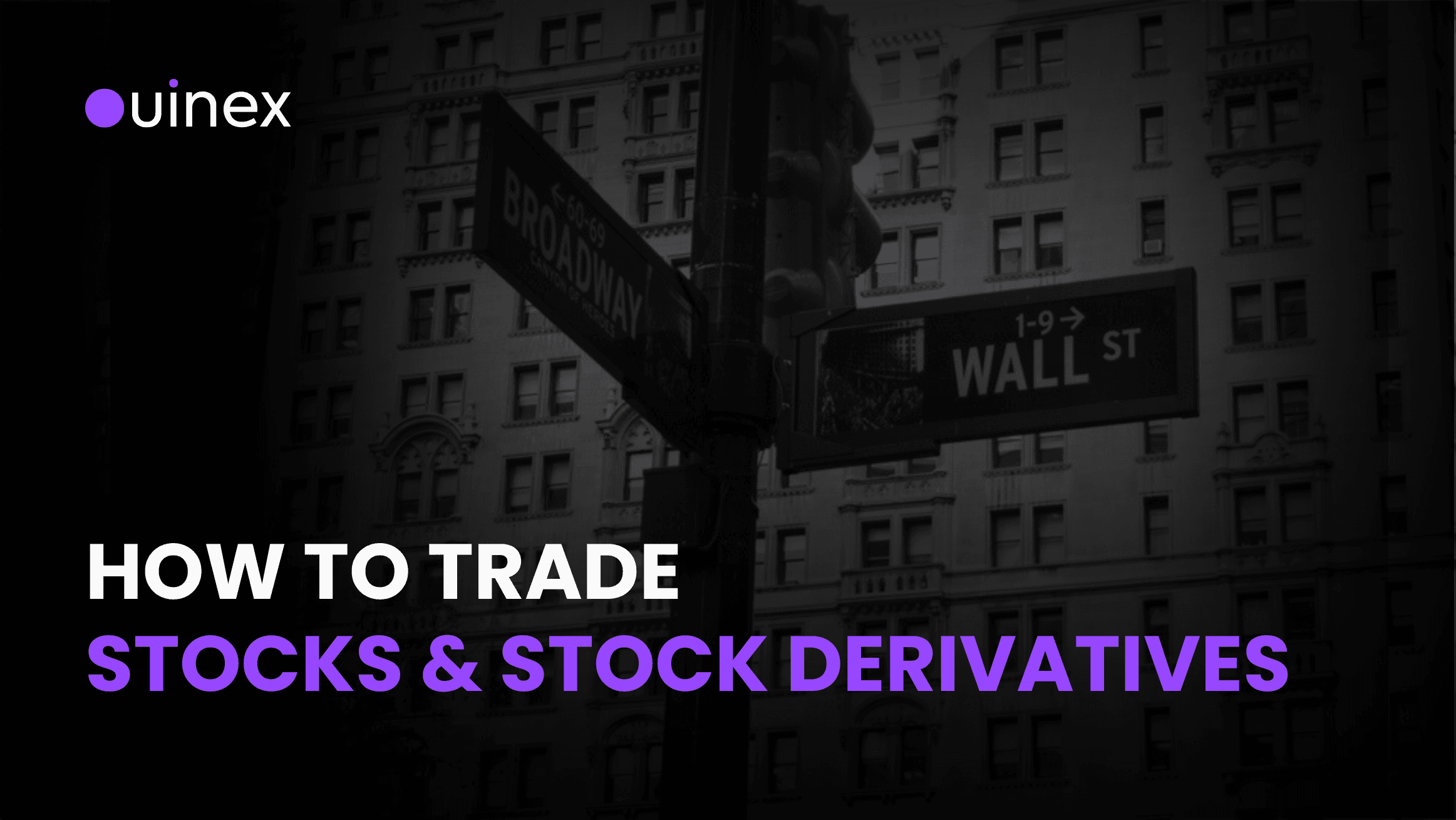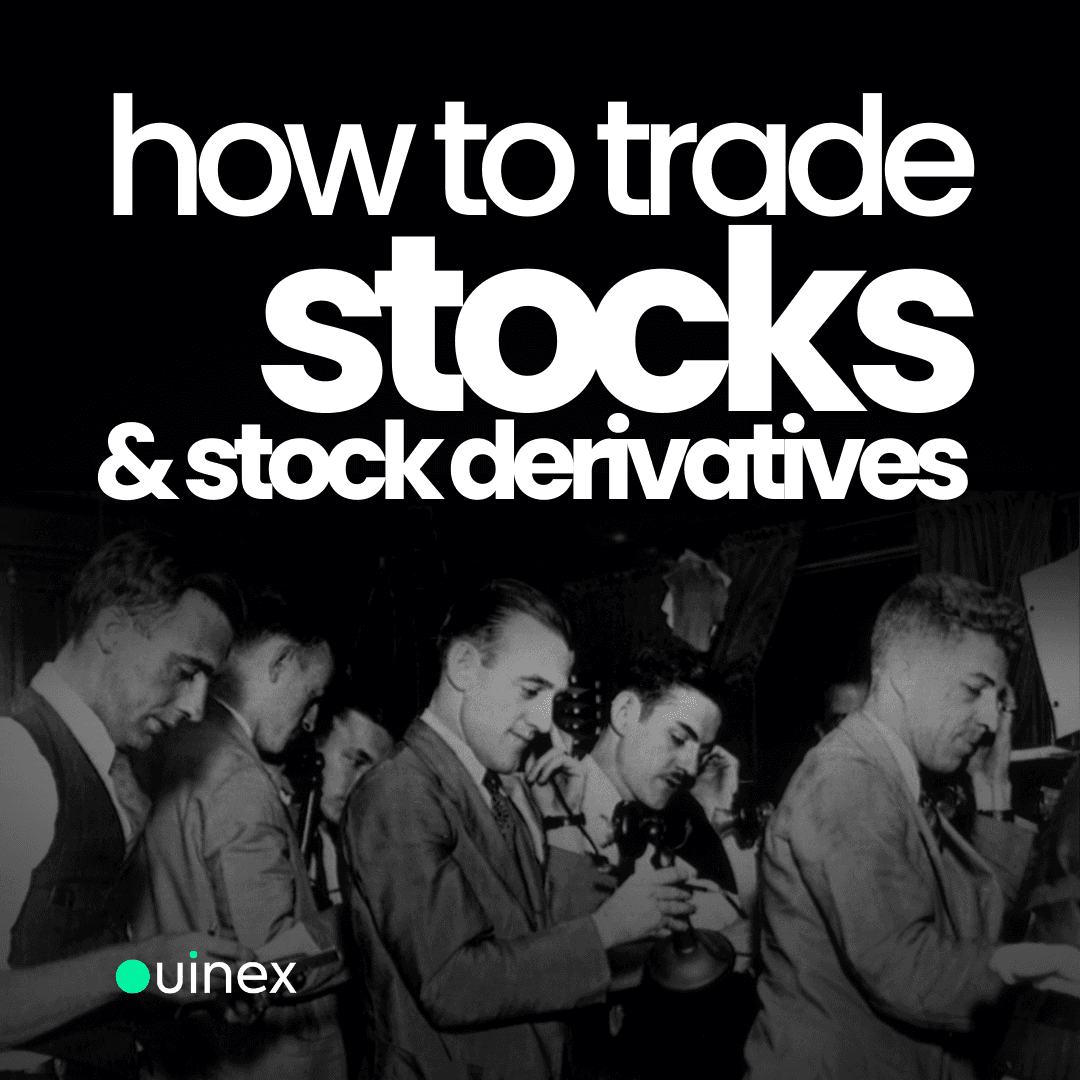
How to Trade Stocks and Stock Derivatives: An Introduction
Please note: This article does not constitute investment advice. Laws governing crypto, derivatives, and other forms of trading and investments—as well as taxation—vary by region and are subject to change. You are responsible for complying with the laws in your jurisdiction. Ouinex’s services and offers, including those mentioned in this article—if any—may vary by location and are subject to change. All investments carry risk.
Entering the stock market can be a powerful way to grow wealth, but traditional methods are often slow and lack flexibility. At Ouinex, we offer a more agile approach by allowing you to trade stock derivatives, which gives you access to the world’s top companies without the constraints of traditional stock ownership. You can use your cryptocurrency as collateral, streamlining the entire process.
Key Takeaways
- Stocks equal ownership, while derivatives offer exposure to price movement without ownership.
- Trading stock derivatives provides the flexibility to go long or short and to use leverage.
- Ouinex allows you to use USDT as margin to trade global stocks and indices, simplifying the funding process.
- Derivatives are a powerful tool for active trading, hedging, and capital-efficient long-term positioning.
- All trading involves risk; always use risk management tools like stop-loss orders.

Stocks vs. Stock Derivatives
Understanding the core difference between these two instruments is crucial when wanting to trade stocks:
- Stocks: When you buy a stock, you become a shareholder, owning a small piece of a company. This is a long-term strategy where you typically profit from price appreciation or dividends. It requires a significant upfront capital investment and is a slower, more passive approach.
- Stock Derivatives (CFDs): With derivatives, you don’t own the stock itself. Instead, you’re trading a contract whose value is derived from the underlying stock’s price. This model is all about trading on price movement, not ownership. This provides several key advantages for active traders.
Basically, with stock derivatives you predict whether the price of a stock will go up or down, and if you’re correct, you earn money.
Why Stock Derivatives Might Be the Smarter Move
Trading stock derivatives, specifically CFDs, offers a level of control and flexibility that traditional stock ownership can’t match.
- Go Long or Short: Derivatives allow you to profit whether you believe a stock’s price will rise (long) or fall (short). This means you can capitalize on volatility in both up and down markets.
- Leverage: Derivatives let you use leverage, meaning you can open a much larger position with a smaller amount of capital (if it’s 10x, investing $50 gives you $500). This increases your capital efficiency and amplifies potential returns (while also increasing potential losses).
- Capital-Efficient Collateral: On Ouinex, you can use your USDT (or other supported crypto) directly as margin to collateralize your stock trades. This eliminates the need for slow bank transfers and fiat conversions.
- Active Trading: Derivatives are ideal for active trading strategies, such as speculating on market events like earnings reports, economic data, or geopolitical news that can cause rapid price swings.
In short, buying stocks in a company is a long-term investment where you only make money if the company goes well. With derivatives, on the other hand, you have the option of buying and selling in seconds and can capitalize on daily market swings. And as you can bet on the price of a stock going down, you can make money in a bear market
Choosing Your Trading Style
Derivatives support various trading strategies, from short-term to long-term:
- Active Trading: Ideal for traders who want to capitalize on short-term volatility and make frequent trades based on market news and technical analysis.
- Index Trading: If you prefer a broader market view, you can trade indices (i.e. a group of stocks) like the S&P 500, Nasdaq, or DAX. This diversifies your exposure with a single trade.
- Long-Term Positioning: Even for longer-term strategies, derivatives can be more capital-efficient than buying and holding. You can maintain a leveraged position on an asset you believe in without tying up all of your capital.
The one thing to bear in mind with derivatives trading is that you should never invest more than you can afford to lose. It’s tempting to use 10x, invest $500 and get $5,000 to trade with. But if things go south, you can also lose $5,000, even though you only invested $500 of your own capital. That’s why stop-losses are so important. Stop-loss orders will allow you to automatically sell off an asset at a certain price point.
What Moves a Stock’s Price?
A stock doesn’t move on its own, it reacts. To what? A mix of fundamentals, sentiment, and macro events. Here’s what to watch:
Earnings Reports
Quarterly earnings are key. Beat expectations and the price might jump. Miss badly and it could drop fast.
Guidance and Forecasts
Strong numbers aren’t enough if the company signals trouble ahead. Investors trade on what’s next, not just what’s now.
Sector Trends
Even solid companies can dip if their entire sector is under pressure. Look at the bigger picture.
Economic Data
Interest rates, inflation, employment figures—macro numbers can move entire markets, especially blue-chip stocks and indices.
News and Headlines
Mergers, lawsuits, product launches, executive shakeups—any headline can swing a stock in seconds.
Market Sentiment
Sometimes it’s not about logic—it’s about mood. Fear and hype can drive price action far beyond fundamentals.
Technical Patterns
Breakouts, support and resistance, trend lines, volume spikes—chart patterns reveal how traders are positioning.
Tip: Stay aware of all of the above to get a good overview. From time to time one thing will be more important than another, but you still need to keep the remain aware of all of the above.
FAQs: Trading Stocks and Derivatives
Do I own the stock when I trade a CFD?
No. You are trading a contract that mirrors the stock’s price. You do not gain ownership rights, such as voting rights or dividend payouts, but you gain full trading flexibility.
What is the main benefit of stock derivatives?
The main benefit is the ability to go long or short (i.e. predict if the price of the stock will go up or down) and use leverage (i.e. margin trading), which provides greater flexibility to profit from market movements and use your capital more efficiently.
Can I use crypto to trade stocks?
Yes. Ouinex allows you to use crypto assets, such as USDT, as collateral to trade derivatives on a wide range of traditional stocks and indices.
Is trading stocks risky?
All trading carries risk. Derivatives, due to leverage, can amplify both gains and losses. It is essential to use risk management tools like stop-loss orders to protect your capital.
How much do I need to start?
Ouinex supports fractional positions, allowing you to start trading with a small amount of fiat, or USDT, and scale your positions as you gain confidence and experience.